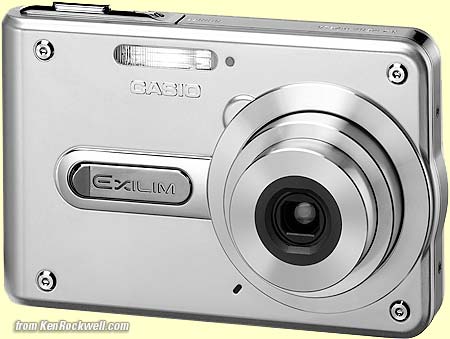Home Search Gallery How-To Books Links Workshops About Contact
|
MOVIES AND SOUND RECORDING return to top of review Movies The movie mode has no adjustments. It's fixed at 320 x 240 pixels at 15 FPS. File format is 300 kB/s DivX AVI format with file suffix ".AVI." You can get about 55 minutes on a 1GB SD card. It both counts down time remaining on your card and counts up time of the shot while shooting. The camera defaults to the hyperfocal distance ("Pan Focus" or PF mode). You may set autofocus or macrofocus before you start the scene, in which case focus is pulled automatically by the S100, unlike my Canon A70 camera. If it's quiet you can hear the AF stepper motor pulling focus in the recorded sound, so avoid the AF mode unless you really need it and don't mind shooting MOS or at least doing a lot of ADR. (MOS: Hollywood lingo for filming without sound. ADR: re-recording and dubbing in the sound later.) Optical zoom doesn't work, probably because if it did you'd hear the tiny motors moving it in the soundtrack. Digital zoom works but looks awful if you zoom too far, just like all digital zooms. Be sure also to turn off any stupid beeps since otherwise you'll record them. Out of common courtesy I always have all the sounds turned off on all my cameras. For most people who leave the camera in it's default mode the camera will beep an AF confirmation if you turn on AF for a movie. The manual cautions against slow SD cards which may cause frames to be dropped while recording a movie. My 32x Lexar card works great. (I doubt it's referring to drop frame vs. non-drop frame in reference to getting 59.94 Hz field rates from 3:2 telecine pulldown since only in Hollywood do we even know what that means. Ignore this, hee hee.) Another secret is the Casio EX-S100 can record sound only and look good doing it. It only uses 4 kB/second. You can turn off the LCD so the only sign the camera is running is the tiny blinking green light. For stealth cover it with some silver tape. Turn the LCD on and it's counting down how much time you have left on your card and how much time you've recorded. You turn the LCD on and off with the DISP button. Turn off the LCD for longer battery life and better stealth. On my 1GB card it told me I had over 66 hours of recording to go, or almost three days on a partially full card. That's right, figure out how to power it and leave it under your wife's bed when you go off on your next photo outing. The manual says the battery is good for 2 - 1/2 hours of audio. I don't know if that's with or without the LCD. I turned off the LCD and got a twelve hour recording before the battery died. It took up 170 MB. Even sneakier, it doesn't look like a recorder. Sneak it into a meeting or secret or highly sensitive discussion you're not supposed to record and leave it in your pocket. This cute little camera doesn't look like a tape recorder, so drop it in a pocket or purse, leave it on, and you'll get it all. One can mark index points while recording. I wasn't able to figure out how to get to them when playing back. Micro audio isn't really that interesting to me. For spies you can use it to mark highlights in a long file while it's in your pocket to save you time finding them later. Adding Audio Notes to Images This is easy. You can do it automatically as you shoot or add and change them later. To do it automatically select the appropriate REC mode. Take the shot and it prompts you to press the shutter again to start and end the recording for the image you just made. After you've made images choose "Dubbing" in the playback menu to record a note for any image. The audio .WAV files have the same name as the image except for the .WAV extension. They're in the same folder as the images. (I think the manual implied otherwise.) If you goof you can record again and it deletes the first audio file. These notes are any length up to 30 seconds and take up 4 kB/second. Thus 5 seconds of notes are only 20 kB, negligible compared to the size of the image file. Next Page: Files, Data and Computational Tricks |

